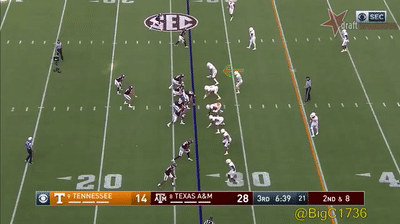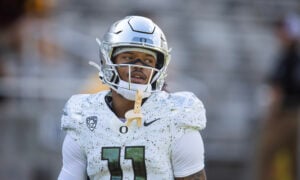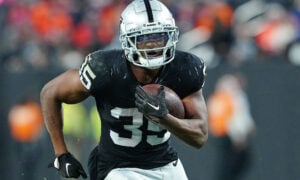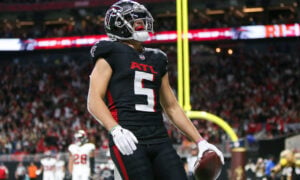IDP 20/20: Derek Barnett
Welcome to the IDP 20/20 series. Alongside our offensive Dynasty Scouts coverage, we will also be profiling and providing 20 facts you must know about 15 of the top incoming IDP rookies in the class.
1.) Name: Derek Barnett
2.) College: The University of Tennessee, Knoxville
3.) Height/Weight: 6-foot-3, 265-pounds
4.) Birth Date: June 26, 1996 (20-years-old)
5.) Class: Junior, (Started 10 games as a freshman, in 2014)
6.) College Stats: Three-year Totals – 198 Tackles, 131 Solos, 52 Tackles For Loss, 32 Sacks. Junior Stats – 56 Total tackles, 40 Solos, 19 TFLs, 13 Sacks
7.) NFL Draft Round Projection – Early-to-Late First Round
[am4show have=’g1;’ guest_error=’sub_message’ user_error=’sub_message’ ]
The projections are literally all over the board. You can scour the interwebs and find Barnett going anywhere from the top ten to the mid-20s. The upcoming slate of combine interviews, as well as the private workouts teams schedule over the next two months, should help us approximate the level of interest in his services more accurately.
8.) Current NFL comp – Cliff Avril
From their physical build, to their playing style, Derek Barnett could be Cliff Avril’s younger brother. They have comparable athletic ability coming around the edge. Watching footage of Avril’s early years in Detroit, you get a feel for this similarity.
Entering his tenth NFL season, Avril has averaged eight sacks a year, and roughly 34 tackles. He’s finished as a top 15 defensive lineman in each of the past two campaigns. IDP owners would love to find the next J.J. Watt, or Khalil Mack. Meanwhile, players who provide the level of consistency Avril has over the years often get overlooked, despite regularly paying dividends for our dynasty teams. Barnett may be able to provide this type of steady output in the near future.
9.) Best possible destination – Any of the Florida teams; but Tampa Bay, or Miami, in particular.
The Buccaneers and Dolphins could each use an edge rusher of Barnett’s ilk. They’ll pick 19th and 22nd, respectively, in round one, where Barnett may still be available. Tampa and Miami each play a base 4-3, which would allow Barnett to settle into a familiar role.
The Bucs currently have Robert Ayers (who’ll turn 32 this September) and second-year pro Noah Spence manning the end positions. Ayers tied tackle Gerald McCoy for the team lead in sacks at 6.5, while Spence and his 5.5 sacks came in second.
Ayers and Spence were also second and third on the team in snaps among defensive ends, behind 25-year-old William Gholston– who’s set to enter free agency this spring. Gholston is known, primarily, for his run defense and has just 10.5 total sacks in four seasons with the Bucs. A Barnett/Spence duo gives Tampa the makings a young and formidable pass rush for the next four to five years.
The story is similar in Miami, where Mario Williams was recently released after a 1.5 sack campaign. The former stud started just five games for the Dolphins in 2016. Cameron Wake had an impressive 11.5 sacks last season. Yet, at 34, his days of producing top-flight production are likely numbered. Playing an astounding 84% of the team’s snaps, Ndamukong Suh was a rock for the resurgent Dolphins, logging a career high 72 total tackles. His five sacks equaled the second lowest total of his seven-year career, however.
With Andre Branch, and his 5.5 QB takedowns set to hit free agency, Suh, Wake, and 30-year-old journeyman Jason Jones, are the only players under contract with more than two sacks last season. Again, Derek Barnett would have an opportunity to generate year-one IDP production for a team in need of sack artist.
10.) Worst possible destination – Indianapolis Colts
Whether Indy would consider drafting Barnett is open to debate. They’ve been a 3-4 team under Chuck Pagano and DC Greg Manusky, but their need for pass rush help should supersede scheme. They managed a mere 33 sacks in 2015, the seventh lowest total in the league.
31-year old Erik Walden was responsible for 11 of those sacks, but his performance was a complete anomaly. 2016 marked just the second time Walden had more than three sacks in any season over his 11-year career. He’ll be a free agent at month’s end, and has regression written all over him. The Colt with the second most sacks in 2016 (five) was Robert Mathis, who announced his retirement in January. After these two, there were six Colts who finished with between two and three sacks last season.
Drafting Derek Barnett would be a solid first step in developing the pass rush Indianapolis needs to elevate their overall defensive effort. Still, he’d have little to no help on the roster as presently constructed, leaving Barnett open to constant double teams, as the focal point of the opposition’s pass protection schemes. The scarcity of impact players on this defense makes the selection of a defender a strong possibility. Yet, without help, any rookie thrown into this mix faces an uphill battle.
11.) Best current skill – Violent Hands
There are many impressive aspects to Barnett’s game, but his hands are perhaps his greatest tool. He’s able to strike and stun tackles, allowing him to shoot past, while they try to recover from the blast. His hands are very effective playing against offensive linemen who outweigh him, and against tight ends and/or running backs… forget it.
12.) Skill that needs to be improved – Open-field tackling
It’s natural for a 260-pound defensive end to have issues tackling smaller, more agile players in the open-field. Too often, however, Barnett will attempt a diving stop on a ball carrier because he fails to get in position to breakdown and tackle. Other times, he elects to lounge for a player rather than cutting off their running lane and forcing them toward another defender or the sideline. These tendencies lend themselves to apprehension about his ability to play in space in the NFL.
13.) Projected dynasty value – Myles Garrett will be the first defensive end selected in your rookie drafts. Barnett will battle Stanford’s Solomon Thomas (whose buzz is growing pre-Combine) and possibly Taco Charlton for the right to be the next edge defender off the board. For months, Barnett has been touted as the second best prospect behind Garrett. This opinion could change quickly once these rookies land on their eventual teams.
For instance, should Thomas wind up playing for the Cardinals – who led the NFL with 48 team sacks, and had three players with eight or more QB takedowns (31.5 between the trio) – while Barnett lands on a team like the Raiders – who had just 25 sacks as a team, and only five players who registered a full sack all year – the belief in which player is best positioned for IDP success could shift by the time your draft rolls around.
14.) Crucial Combine – Barnett doesn’t possess the type of freakish athleticism Myles Garrett and Taco Charlton do. His strength doesn’t appear to be an issue in-game. But, he’ll need to show teams he has the short area quickness and agility they covet to ensure his selection in the top half of round one. If he can’t demonstrate better body lean in shorts than he’s put on tape, it may cause some scouts to knock him down a few spots on their boards.
15.) Don’t lean in too far – “Body lean” coming around the edge is one of the most important traits a pass rusher can possess. It allows them to use the speed advantage they hold over most offensive tackles, while nullifying their size disadvantage with better leverage. At times, Barnett is able to disengage from a tackle trying to ride him around the pocket, and rush off the tackle’s inside shoulder to force the quarterback’s hand. But often times, he’s taken out of the rush completely.
Some of this has to do with Barnett’s initial burst off the line. He tends to “get off” slower when the offense isn’t in an obvious passing situation, thus giving his blocker more time to set up. Some of this also has to do with a lack of flexibility. In either event, this is something pro scouts will probe in his upcoming workouts.
16.) Better fit for a 4-3 than a 3-4 – We spoke about Myles Garrett being a better fit in a 4-3 scheme last week. Much of this argument has to do with the limited exposure Garrett had to pass defense at Texas A&M. Barnett dropped into coverage more often than Garrett, yet the same conclusion can be drawn about their best scheme fit in the pros.
Barnett appears more comfortable defending the flats than he does in hook zones or man coverage. Here, he reads the back leaking into the flat, and transitions smoothly out of his stance and into coverage. If they play were allowed to develop, however, the running back would have destroyed Barnett once they turned upfield.
In man, only an underthrown ball saves Barnett from a long sprint, and a dejected walk back to the sideline.
The issue with the last play is Barnett’s failure to turn his head. Granted, he was asked to run with fellow Combine invitee Josh Reynolds (for some cruel and unusual reason), an assignment he couldn’t have felt very comfortable with. He had the presence to recognize Reynolds was pulling up and eyeing the catch, but without getting his head around, Barnett risk earning an interference call, and penalties cost points – both in the NFL and some fantasy leagues.
His failure to play the ball leads back to the agility issue. Barnett would get lost trying to defend a move tight end who gives him a shake before running an in-breaking route. He may be able to execute the occasional zone drop down the seem or to the flat, but these aren’t situations you want to see him in with regularity.
17.) Did we mention his “get off” can be slow?
This is a fairly consistent flaw in Barnett’s game. As impressive as his career sack and tackles for loss numbers were, they’re almost more remarkable in light of how delayed his first step can be. As an edge defender who must stay honest and keep contain, there’s a built-in tendency to watch things develop in the backfield. This isn’t Barnett’s problem, however. He simply appears hesitant to fire off the ball when he’s unsure if the play is a run or a pass.
Naturally, this is most prevalent on first downs. On third-and-long, or second-and-short – he’s Jesse Owens getting out of the blocks. Tendencies like this are overcome easier in the collegiate ranks. In the NFL, the consequences for every misstep will be magnified.
18.) Barnett is tenacious, with a bit of a mean streak – It may seem like we’ve spent a lot of time trashing Derek Barnett’s game, but there is a lot to like in this player. He plays with a level of fortitude and drive which can overpower his opponents. Barnett can impact plays even when he’s not the one taking down the ball carrier. He also has a bit of a mean streak.
19.) Tied Reggie White for Tennessee’s all-time sack record – Ending his career in Knoxville with 32 sacks in three seasons, Barnett joined the great Reggie White atop the Volunteers’ all-time sack list. White maintains the single-game record, with four, as well as the single-season record of 15. Yet, Barnett was able to match his feat in one less season of action than the “Minister of Defense” who played four years for the Vols.
He is the only player in SEC history to record ten or more sacks in three consecutive seasons, as well as the conference’s career sack leader dating back to 2005, a timeframe which places Barnett ahead of such luminaries as Justin Houston, Jadeveon Clowney, and Myles Garrett.
20.) The following is a link to one of Derek Barnett’s best statistical games, a three tackle for loss, three sack effort against the South Carolina Gamecocks from 2016. Enjoy.
[/am4show]
- Dynasty Capsule: Seattle Seahawks - January 17, 2018
- FanDuel Bargains: Week Five - October 8, 2017
- IDP Report Card: Week 4 - October 8, 2017





































































